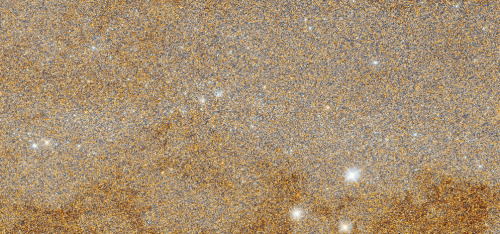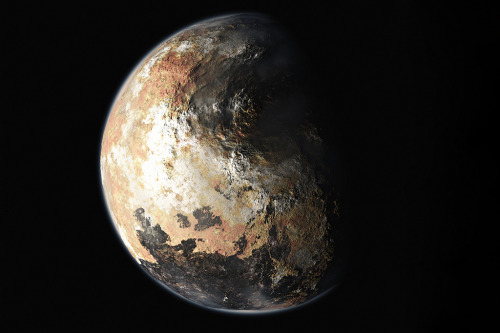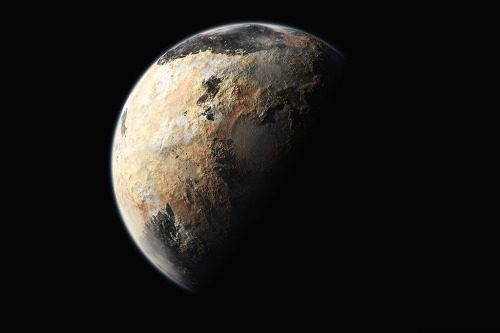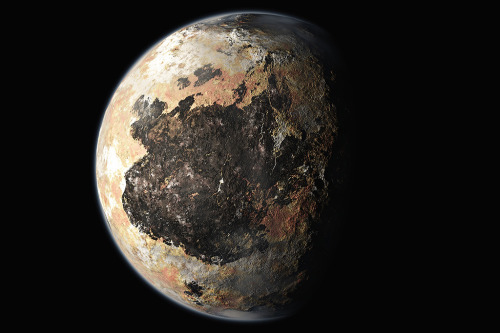littlecadet-biguniverse
GREETINGS FROM EARTH! Welcome to my space blog! Let's explore the stars together!!!
144 posts
Latest Posts by littlecadet-biguniverse

Cargo transfer bags come in various sizes. I actually fit into this one and as a joke, Thomas and Shane took me over to the Russian segment, zipped inside. They told them there was a present inside and opened it up. I popped out and gave them a good surprise!

This beautiful supernova remnant is the product of a huge stellar explosion in our neighboring galaxy — the Small Magellanic Cloud (📷 : NASA)
Hubble Peers into the Storm
NASA - Hubble Space Telescope patch. Sept. 9, 2016
This shot from the NASA/ESA Hubble Space Telescope shows a maelstrom of glowing gas and dark dust within one of the Milky Way’s satellite galaxies, the Large Magellanic Cloud (LMC). This stormy scene shows a stellar nursery known as N159, an HII region over 150 light-years across. N159 contains many hot young stars. These stars are emitting intense ultraviolet light, which causes nearby hydrogen gas to glow, and torrential stellar winds, which are carving out ridges, arcs, and filaments from the surrounding material. At the heart of this cosmic cloud lies the Papillon Nebula, a butterfly-shaped region of nebulosity. This small, dense object is classified as a High-Excitation Blob, and is thought to be tightly linked to the early stages of massive star formation.
Hubble orbiting Earth
N159 is located over 160,000 light-years away. It resides just south of the Tarantula Nebula (heic1402), another massive star-forming complex within the LMC. This image comes from Hubble’s Advanced Camera for Surveys. The region was previously imaged by Hubble’s Wide Field Planetary Camera 2, which also resolved the Papillon Nebula for the first time. Related links: heic1402: https://www.spacetelescope.org/news/heic1402/ Hubble’s Wide Field Planetary Camera 2: https://www.spacetelescope.org/about/general/instruments/wfpc2/ For more information about the Hubble Space Telescope, visit: http://hubblesite.org/ http://www.nasa.gov/hubble https://www.spacetelescope.org/ Image, Video, Text, Credits: ESA/Hubble & NASA/Text credit: European Space Agency/NASA/Karl Hille. Greetings, Orbiter.ch Full article

Vdb 158 and PLN 110-12.1
Credit: Jimmy Walker

NGC 3576, an emission nebula in the constellation of Carina 6,000 light years away. -image via paulhaese.net
Solar System: Things to Know This Week
Our solar system is huge, so let us break it down for you. Here are a few things to know this week:
1. We’re Going In

To be honest, Jupiter is kind of a monster. Not only is it the biggest planet in the solar system, but it also wields the most dangerous radiation and other powerful forces. Despite the risks, our Juno probe is going in close, because Jupiter also holds precious clues to how the planets formed, including our own. Arrival date: July 4. Watch the Juno mission trailer video HERE.
2. Moon Maps

The moon is beautiful in the sky, and also up close—sometimes even in the maps that scientists use to study its surface. Here are some evocative maps that lunar geologists have drawn up to chart the landscapes in the moon’s dramatic Tycho Crater. Take a look HERE.
3. That’s No Moon…Sort Of

The full moon we’ll see this week is not Earth’s only companion in space. Astronomers have discovered a small asteroid in an orbit around the sun that keeps it near the Earth, where it will remain for centuries. But it’s not exactly a second moon, either.
4. Power Blast

Venus has an “electric wind” strong enough to remove the components of water from its upper atmosphere, which may have played a significant role in stripping Earth’s twin planet of its oceans, according to new results from the European Space Agency (ESA) Venus Express mission by NASA-funded researchers.
5. How Green (Well, Red) Was My Valley

“Marathon Valley” slices through the rim of a large crater on Mars. It has provided fruitful research targets for our Opportunity rover since July 2015, but now the rover’s team is preparing to move on.
Want to learn more? Read our full list of the 10 things to know this week about the solar system HERE.
Make sure to follow us on Tumblr for your regular dose of space: http://nasa.tumblr.com


Top: Hubble’s infrared vision pierced the dusty heart of our Milky Way galaxy to reveal more than half a million stars at its core. At the very hub of our galaxy, this star cluster surrounds the Milky Way’s central supermassive black hole, which is about 4 million times the mass of our sun.
Credits: NASA, ESA, and Hubble Heritage Team (STScI/AURA, Acknowledgment: T. Do, A.Ghez (UCLA), V. Bajaj (STScI)
Bottom: This annotated, infrared image from the Hubble Space Telescope shows the scale of the galactic core. The galaxy’s nucleus (marked) is home to a central, supermassive black hole called Sagittarius A-star.
Credits: NASA, ESA, and the Hubble Heritage Team (STScI/AURA) Acknowledgment: T. Do, A.Ghez (UCLA),V. Bajaj (STScI)

Rosette Field

Blue bursts of hot young stars
js
Do telescopes actually take colorful photographs or are the pretty colorful photographs of galaxies that we know colored afterwards? If a human was floating through space, would space look colorful to them?
So some pictures are taken in different wavelengths to see different characteristics. (infrared wavelengths to see through thick gas and dust, xray wavelengths to see highly energized regions)
But, in the visible wavelengths you are seeing the colors. They’re just enhanced brighter than they might be.
For example, I took this picture of “the California Nebula” using a camera (Canon 60Da) attached to a telescope. This shows one exposure, and the background is red due to effects of the camera (which you subtract):

You take multiple exposures, combine them, subtract the background effects & adjust the color a little and get this…



The Department of Awesome Natural Phenomena has features amazing auroras before, but never an aurora on another planet! This extraordinary sight, brought to us by the NASA/ESA Hubble Space Telescope, is an incredibly colossal aurora taking place on Jupiter:
“At the gas giant’s north pole, the most powerful and luminous northern lights in the solar system shimmer and glow in an endless geomagnetic storm that’s larger than our entire planet.”
That’s right, Jupiter itself is already so awesomely huge that its auroras are larger than the planet Earth.
Watch this time-lapse video of the Jupiter auroras and then visit the Hubble website to learn more about this amazing phenomena.
[via Twisted Sifter and Gizmodo]

These three bright nebulae are often featured in telescopic tours of the constellation Sagittariusand the crowded starfields of the central Milky Way.
In fact, 18th century cosmic touristCharles Messier cataloged two of them; M8, the large nebula left of center, and colorful M20 near the bottom of the frame. The third, NGC 6559, is right of M8, separated from the larger nebula by dark dust lanes. All three are stellar nurseries about five thousand light-years or so distant. The expansive M8, over a hundred light-years across, is also known as the Lagoon Nebula. M20’s popular moniker is the Trifid.
In the composite image, narrowband data records ionized hydrogen, oxygen, and sulfur atoms radiating at visible wavelengths. The mapping of colors and range of brightness used to compose this cosmic still life were inspired by Van Gogh’s famous Sunflowers.
Just right of the Trifid one of Messier’s open star clusters,M21, is also included on the telescopic canvas.
Object Names: M8, M20, M2, NGC 6559
Image Type: Astronomical
Credit: NASA, AndrewCampbell
Time And Space
(NASA)
The Juno spacecraft just recorded these creepy sounds around Jupiter
Via Science Alert


Juno Arrives at Jupiter Today!
Today on the 4th of July, 2016 (barring any tragic occurrence with the engine firing) NASA’s Juno spacecraft will enter into orbit around Jupiter.
It’s been traveling since 2011 and carries thick shielding to protect its instruments from the dangerous fields of radiation surrounding the planet.
Juno’s not the first spacecraft to go to Jupiter, but it will be the closest. I like to imagine that Juno will look like a scene from Alien: Isolation where you get to look out the window and see that massive gas giant below you.
The goals of this mission are essentially thus: investigate the weather, atmosphere and magnetosphere on Jupiter.
Moving into a grander context, as answers start to come in and we learn more about Jupiter’s nature we hope to learn more about the questions we must be asking in order to investigate the formation of our very solar system on a deeper level.
Of course with any luck and a lot of hard work, we will be able to build a more harmonious theory of how a star system forms, and the things that go into the construct of a massive gas giant.
(Image credit: NASA and JPL)

TODAY IN HISTORY: On July 31, 1971, moonwalker Jim Irwin works at the lunar rover the first EVA of the Apollo 15 mission. In the background is Mount Hadley. Photo by Dave Scott. (NASA)

Hubble views a spectacular supernova with interstellar material over 160,000 light-years away by NASA Goddard Photo and Video on Flickr.
This NASA/ESA Hubble Space Telescope image captures the remnants of a long-dead star. These rippling wisps of ionized gas, named DEM L316A, are located some 160,000 light-years away within one of the Milky Way’s closest galactic neighbors — the Large Magellanic Cloud (LMC). The explosion that formed DEM L316A was an example of an especially energetic and bright variety of supernova, known as a Type Ia. Such supernova events are thought to occur when a white dwarf star steals more material than it can handle from a nearby companion, and becomes unbalanced. The result is a spectacular release of energy in the form of a bright, violent explosion, which ejects the star’s outer layers into the surrounding space at immense speeds. As this expelled gas travels through the interstellar material, it heats up and ionizes it, producing the faint glow that Hubble’s Wide Field Camera 3 has captured here. The LMC orbits the Milky Way as a satellite galaxy and is the fourth largest in our group of galaxies, the Local Group. DEM L316A is not the only supernova remnant in the LMC; Hubble came across another one in 2010 with SNR 0509, and in 2013 it snapped SNR 0519. Image credit: ESA (European Space Agency)/Hubble & NASA, Y. Chu
Just so you know, you can always watch the Earth live from the ISS. Its really relaxing to me

A shot of just a tiny bit of the Andromeda Galaxy, from the sharpest ever view taken by the Hubble Space Telescope
Full size image

M63, Sunflower Galaxy

New view of the Pillars of Creation
js

Infrared Saturn Clouds via NASA http://ift.tt/2b5OdPE

A Black Hole Choir : The blue dots in this field of galaxies, known as the COSMOS field, show galaxies that contain supermassive black holes emitting high-energy X-rays.
js
'Enterprise' Nebulae Seen by Spitzer
NASA - Spitzer Space Telescope patch. Sept. 8, 2016
Image above: These nebulae seen by NASA’s Spitzer Space Telescope, at left, may resemble two versions of the starship Enterprise from “Star Trek,” overlaid at right. Image Credits: NASA/JPL-Caltech. Just in time for the 50th anniversary of the TV series “Star Trek,” which first aired September 8th,1966, a new infrared image from NASA’s Spitzer Space Telescope may remind fans of the historic show. Since ancient times, people have imagined familiar objects when gazing at the heavens. There are many examples of this phenomenon, known as pareidolia, including the constellations and the well-known nebulae named Ant, Stingray and Hourglass. On the right of the image, with a little scrutiny, you may see hints of the saucer and hull of the original USS Enterprise, captained by James T. Kirk, as if it were emerging from a dark nebula. To the left, its “Next Generation” successor, Jean-Luc Picard’s Enterprise-D, flies off in the opposite direction. Astronomically speaking, the region pictured in the image falls within the disk of our Milky Way galaxy and displays two regions of star formation hidden behind a haze of dust when viewed in visible light. Spitzer’s ability to peer deeper into dust clouds has revealed a myriad of stellar birthplaces like these, which are officially known only by their catalog numbers, IRAS 19340+2016 and IRAS19343+2026. Trekkies, however, may prefer using the more familiar designations NCC-1701 and NCC-1701-D. Fifty years after its inception, Star Trek still inspires fans and astronomers alike to boldly explore where no one has gone before.
Spitzer Space Telescope. Image Credits: NASA/JPL-Caltech
This image was assembled using data from Spitzer’s biggest surveys of the Milky Way, called GLIMPSE and MIPSGAL. Light with a wavelength of 3.5 microns is shown in blue, 8.0 microns in green, and 24 microns in red. The green colors highlight organic molecules in the dust clouds, illuminated by starlight. Red colors are related to thermal radiation emitted from the very hottest areas of dust. JPL manages the Spitzer Space Telescope mission for NASA’s Science Mission Directorate, Washington. Science operations are conducted at the Spitzer Science Center at Caltech in Pasadena, California. Spacecraft operations are based at Lockheed Martin Space Systems Company, Littleton, Colorado. Data are archived at the Infrared Science Archive housed at the Infrared Processing and Analysis Center at Caltech. Caltech manages JPL for NASA. For more information about Spitzer, visit: http://spitzer.caltech.edu http://www.nasa.gov/spitzer Images (mentioned), Text, Credits: NASA/Tony Greicius/JPL/Elizabeth Landau/Written by Robert Hurt, NASA’s Spitzer Science Center. Greetings, Orbiter.ch Full article

Amazing photo of the south pole of Mars.

Andromeda glowing in infrared.

The remnants of a supernova, which usually leaves behind a neutron star. However, no such x-rays have been discovered. Could this be the youngest black hole in the milky way?

Saturn in three bands of infrared light.




